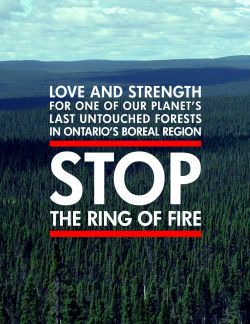My name is Neecha. I’m from the Ojibway Nation of Saugeen Indian Tribe. In the 1970s, I was adopted out by the Children’s Aid Society (CAS) and deprived of my language, Ojibway.
When I turned eighteen I wanted to go home. All I knew were my parents’ first names; however, it turned out that my mother had gone to the CAS on my eighteenth birthday to update her contact information, so I was able to easily find her. I met my dad a couple years later and reunited with my father’s side. I stayed in Thunder Bay for eleven years. While I was there, I began to learn about the history of what happened to our people.
My world changed in 2004. On August 19th, the Ministry of Natural Resources (MNR) and the company Bowater told our elders to get off the land so they could aerial spray it. We sent an email to the MNR saying that we didn’t agree with their plans to aerial spray our lands because, first of all, we didn’t even know what they were talking about. Then we learned that aerial sprays contain a toxic mix of pesticides and herbicides, which are used to kill natural vegetation in the forest in order to enhance timber stands. We also found out that Bowater pays 0% royalties to our Nation to clear-cut our land.
Can you speak more about the support work you’ve done with Grassy Narrows?
When I learned that there was going to be a gathering at Grassy Narrows I invited my friends from Six Nations to come because we were all dealing with similar struggles. We gathered two van loads of people from Six Nations and travelled up there. We had an amazing gathering and we shared information about our struggles.
A few days into the gathering, we decided to stop traffic on the Trans-Canada highway. We had an agreement with the Ontario Provincial Police (OPP) to end our blockade after a set time and in exchange no arrests would be made. We respected that timeline, but the next day the OPP took us into custody. They knew I was pregnant at the time, but they still came into my cell and beat me up. I had a miscarriage ten days later.
How did you get involved with opposing the Ring of Fire (mining development) in Ontario?
I first found out about the project when my cousin brought the proposal documents from Mishkeegogamang down to Ottawa. We tried to use the Access to Information Privacy Act to find out exactly what had been negotiated and who had been signing off on it. We found out later that my father’s trap line sits right in the northward corridor of the Ring of Fire, yet no one ever contacted my family.
Can you tell us more about your father’s trap line?
My father’s trap line sits on the Pipestone waterways which connect to the Albany River and Lake St. Joseph. All the trap lines are connected by waterways. We also have wild rice up there, which would be contaminated by the proposed mining projects.
Right now, the MNR is declaring it commercial land, but it’s not commercial land: it is inherited land. Our land has been passed down from generation to generation. I don’t understand how people think they can come and take land that doesn’t belong to them. Many families belong to each trap line, so they’re not just dealing with me; they’re dealing with our whole nation.
Do you want to tell us more about the Ring of Fire?
As Anishinaabe kwe (women), our role is to ensure the water continues to flow and give life to our next generations. We researched the consequences of chromium mining in other countries and found that it poisons waterways. If that happens here, our forest will be devastated. These corporations would barrel down the boreal forest, suck it dry, and leave.
Is there anything you want to add?
Our lands are crucial. As a First Nations woman who was adopted and taken off the land, it has been important for me to reconnect with the land and my people, as well as to learn our history. When they talk about reconciliation and healing, they are missing the biggest piece: our land. When that piece is gone, it’s impossible to heal.
Sidebar: The Ring of Fire
The Ring of Fire is a massive mining and smelting operation proposed in the James Bay Lowlands region of northern Ontario. The Ring of Fire, called “Ontario’s Oil Sands” by MP Tony Clement, will primarily exploit the region’s large chromite reserves but will also yield silver, nickel, and other minerals. Many proposed sites will be open pit mines and will destroy waterways in the sensitive wetland ecosystem. Native trap-lines are already being revoked by the government to make room for this project. If built, this project will disrupt Cree and Anishinabek hunting, fishing, and trapping, and will open up northern Ontario to further industrial destruction.



